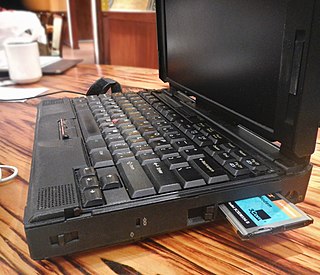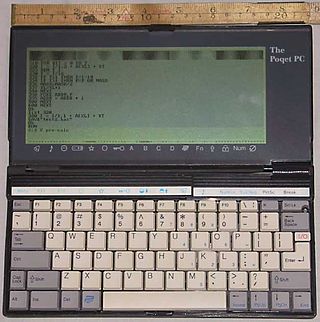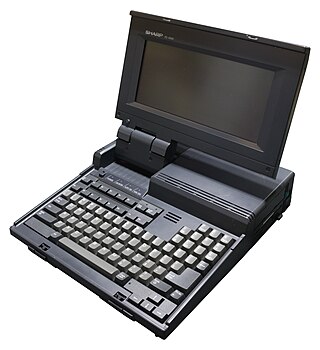Related Research Articles

PC Card is a parallel peripheral interface for laptop computers and PDAs.

The Personal Computer Memory Card International Association (PCMCIA) was a group of computer hardware manufacturers, operating under that name from 1989 to 2009. Starting with the PCMCIA card in 1990, it created various standards for peripheral interfaces designed for laptop computers.

The Poqet PC is a very small, portable IBM PC compatible computer, introduced in 1989 by Poqet Computer Corporation with a price of $2000. The computer was discontinued after Fujitsu Ltd. bought Poqet Computer Corp. It was the first subnotebook form factor IBM PC compatible computer that ran MS-DOS. The Poqet PC is powered by two AA-size batteries. Through the use of aggressive power management, which includes stopping the CPU between keystrokes, the batteries are able to power the computer for anywhere between a couple of weeks and a couple of months, depending on usage. The computer also uses an "instant on" feature, such that after powering it down, it can be used again immediately without having to go through a full booting sequence. The Poqet PC is comparable to the HP 95LX/HP 100LX/HP 200LX and the Atari Portfolio handheld computers.

ExpressCard, initially called NEWCARD, is an interface to connect peripheral devices to a computer, usually a laptop computer. The ExpressCard technical standard specifies the design of slots built into the computer and of expansion cards to insert in the slots. The cards contain electronic circuits and sometimes connectors for external devices. The ExpressCard standard replaces the PC Card standards.

AST Research, Inc., later doing business as AST Computer, was a personal computer manufacturer. It was founded in 1980 in Irvine, California, by Albert Wong, Safi Qureshey, and Thomas Yuen, as an initialism of their first names. In the 1980s, AST designed add-on expansion cards, and evolved toward the 1990s into a major personal computer manufacturer. AST was acquired by Samsung Electronics in 1997 but was de facto closed in 1999 due to a series of losses.

The PowerBook 500 series is a range of Apple Macintosh PowerBook portable computers first introduced by Apple Computer with the 540c model on May 16, 1994. It was the first to have stereo speakers, a trackpad, and Ethernet networking built-in.

Mwave was a technology developed by IBM allowing for the combination of telephony and sound card features on a single adapter card. The technology centers around the Mwave digital signal processor (DSP). The technology was used for a time to provide a combination modem and sound card for IBM's Aptiva line and some ThinkPad laptops, in addition to uses on specialized Mwave cards that handled voice recognition or ISDN networking connectivity. Similar adapter cards by third-party vendors using Mwave technology were also sold. However, plagued by consumer complaints about buggy Mwave software and hardware, IBM eventually turned to other audio and telephony solutions for its consumer products.
Xircom, Inc., was an American computer networking hardware and mobile technology company. Headquartered in Thousand Oaks, California, Xircom was one of the first companies to develop network computing products for notebook computers. Products included computer memory cards, LAN adapters, modems, and remote access server products. The company's products enabled notebook users to share information over a network connection.
COM One group was a manufacturer best known for its computer network adapters. The company was co-founded in 1987 by Jacques Saubade and Michel Petit and was headquartered in France. The name comes from the company's focus on modems.

Global Village Communication Inc. was a leading manufacturer of easy-to-use fax modems and other telecommunications products for Apple's Macintosh platform. It was one of the few manufacturers to support the Mac's RS-422 serial ports without requiring an adapter. Major product lines included the TelePort series of high-speed desktop dial-up modems, and the PowerPort series of internal PowerBook modems, as well as a series of modems that connected to the Mac's ADB port. Many of its products were bundled with the Macintosh Performa series of computers, and it was the manufacturer for the internal modem in the PowerBook 500 series.

The Palm Top PC 110 is a handheld personal computer that was developed jointly by IBM's Japanese subsidiary and Ricoh. It was released exclusively in Japan in September 1995. It used the Intel 80486SX microprocessor and was available in three different configurations. It used a Japanese keyboard, could be used in a docking station, and had a modem connection. During the development phase, the size was decreased. After the release, it was received positively for the number of features, but negatively for the small keyboard.

Reply Corporation, often shortened to Reply Corp., was an American computer company based in San Jose, California. Founded in 1988 by Steve Petracca, the company licensed the Micro Channel architecture from IBM for their own computers released in 1989, competing against IBM's PS/2 line. The company later divested from offering complete systems in favor of marketing motherboard upgrades for older PS/2s. Reply enjoyed a close relationship with IBM, owing to many of its founding employees, including Petracca, having worked for IBM. The company was acquired by Radius in 1997.

The Sharp PC-4500 is a line of laptop computers released by Sharp Corporation in 1987. The line comprises the PC-4501, the PC-4502, and the PC-4521. The PC-4501 is a bare-bones unit with only 256 KB of RAM stock, only one floppy drive, no backlighting, and no built-in numeric keypad; the PC-4502 and PC-4521 bumps the stock RAM to 640 KB and includes the latter two features while providing either two floppy drive (PC-4502) or one floppy drive and a 20 MB hard drive (PC-4521). Prices on the line initially ranged from $1,295 to just under $3,000; the PC-4501 was later sold for $995, becoming one of the first sub-$1,000 laptops available on the market. The PC-4500 line received mixed, mostly positive, reviews on its release in September 1987.

Cumulus Corporation was an American computer peripheral and system manufacturer active from 1987 to 1993. Based in Beachwood, Ohio and started by Tecmar founder Martin Alpert, the company set out to exclusively manufacture expansion products for IBM's Personal System/2 (PS/2) family of computers—mainly RAM expansion cards. It later released cross-platform CPU upgrade cards and memory expansion cards for other platforms besides the PS/2. Beginning in 1990, the company began trading as Cumulus Computer Corporation and began releasing complete systems of their own. Initially a success story for the tech industry in Cleveland, a botched stock launch in 1992 proved disastrous for the company's ailing cash flow situation, and in 1993 the company was liquidated amid massive debt to suppliers and lenders.

Boca Research, Inc., later Inprimis, Inc., was an American computer company based in Boca Raton, Florida, and active between 1985 and 2002. The company manufactured a variety of expansion cards for the IBM PC and compatible systems, including memory cards, networking cards, sound cards, and graphics cards. Once a major player in the computer networking market, being the fourth-largest manufacturer of modems in 1996, Boca Research abandoned the PC hardware market entirely amid falling market share and manufactured set-top boxes in the last years of its existence.

Reveal Computer Products, Inc., was a short-lived American computer peripheral manufacturer active from 1992 to 1996. It was established as a subsidiary of Packard Bell Electronics, an American computer company. The company was once a major player in the IBM PC peripheral market, with annual sales peaking above the US$200 million mark. It went bankrupt in 1996 after an aborted $65-million merger with Creative Technology.

BusLogic, Inc., was an American computer company active from 1988 to 1996. It specialized in the production of Small Computer System Interface (SCSI) device controller chips and controller expansion cards, becoming a dominant player in that market, behind only Adaptec. In 1996, the company was acquired by Mylex Corporation.

Genoa Systems Corporation, later Genoa Electronics Corporation, was an American computer multimedia peripheral vendor based in San Jose, California, and active from 1984 to 2002. The company was once a prolific and well-known manufacturer of video cards and chipsets. They also dabbled in modems, tape drives, sound cards, and other peripheral expansion cards. The company was a founding member of the Video Electronics Standards Association (VESA) and were instrumental in the development of Super VGA.
Micronics Computers, Inc. was an American computer company active from 1986 to 1998 that manufactured complete systems, motherboards, and peripherals. Based in the San Francisco Bay Area, Micronics was one of the largest domestic motherboard manufacturers in the United States in the 1990s. After acquiring Orchid Technology in 1994, the company entered the market for multimedia products, such as graphics adapters and sound cards. In 1998, Micronics was acquired by Diamond Multimedia.

The LTE Elite was a series of notebook-sized laptops under the LTE line manufactured by Compaq from 1994 to 1996. All laptops in the LTE Elite range sported Intel's i486 processors, from the 40 MHz DX2 to the 75 MHz DX4. The LTE Elite was the first notebook-sized laptop to house the AC adapter inside the case itself, eliminating the need to carry an external power brick. The LTE Elite line was replaced by the LTE 5000 series in 1995. Compaq ceased manufacturing the LTE Elite line in March 1996.
References
- ↑ Vranizan, Michelle (May 19, 1992). "Toshiba hires marketing VP for computer-systems unit". The Orange County Register: C2 – via ProQuest.
- 1 2 3 4 5 6 7 8 9 Lyster, Michael (October 30, 1995). "Circuit board maker at critical juncture". Orange County Business Journal. American City Business Journals. 18 (44): 1 – via ProQuest.
- 1 2 3 4 5 Takahashi, Dean (November 16, 1993). "Growth Is in the PCMCIA Cards for PC-Product Makers". Los Angeles Times. Times-Mirror Company: 6 – via ProQuest.
- 1 2 Levy, Melissa (October 17, 1994). "New Media expands distribution network". Orange County Business Journal. American City Business Journals. 17 (42): 14 – via ProQuest.
- ↑ Torgan, Emerson Andrew (December 22, 1992). "Briefs". PC Magazine. Ziff-Davis. 11 (22): 59 – via Google Books.
- ↑ Loudermilk, Stephen (May 31, 1991). "Wireless LANs, PCMCIA cards make their mark at Comdex". PC Week. Ziff-Davis. 10 (21): 24 – via Gale.
- ↑ Staff writers (December 12, 1995). "O.C. State/Briefly". The Orange County Register: C2 – via ProQuest.
- ↑ McConnell, Stacy A.; Linda D. Hall, eds. (1998). Industry Reference Handbooks. Dun and Bradstreet/Gale. p. 298. ISBN 9780787630409 – via the Internet Archive.
- ↑ Zakar, Peter (2000). Southern California Job Source. Benjamin Scott Publishing. p. 336. ISBN 9781891926044 – via the Internet Archive.
- ↑ "New Media Technology Corporation". OpenCorporates. n.d. Archived from the original on July 14, 2023.
- ↑ O'Grady, Jason D. (January 16, 2006). "PC Card = Obsolete". ZDNET. Ziff-Davis.